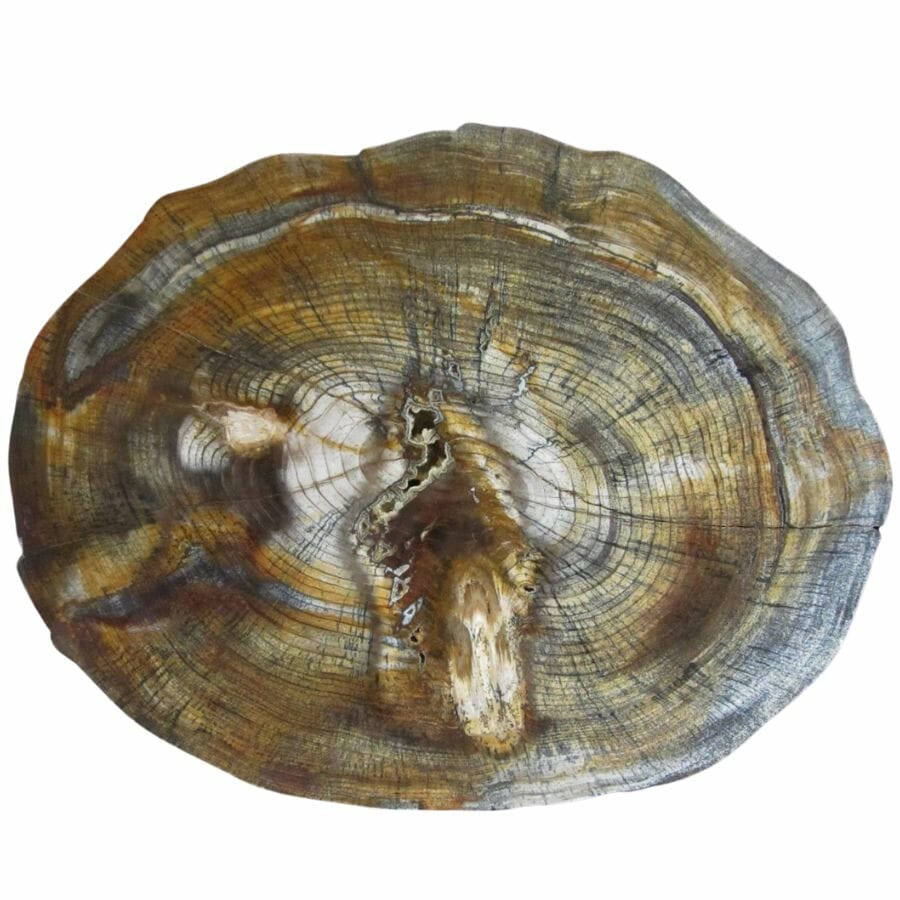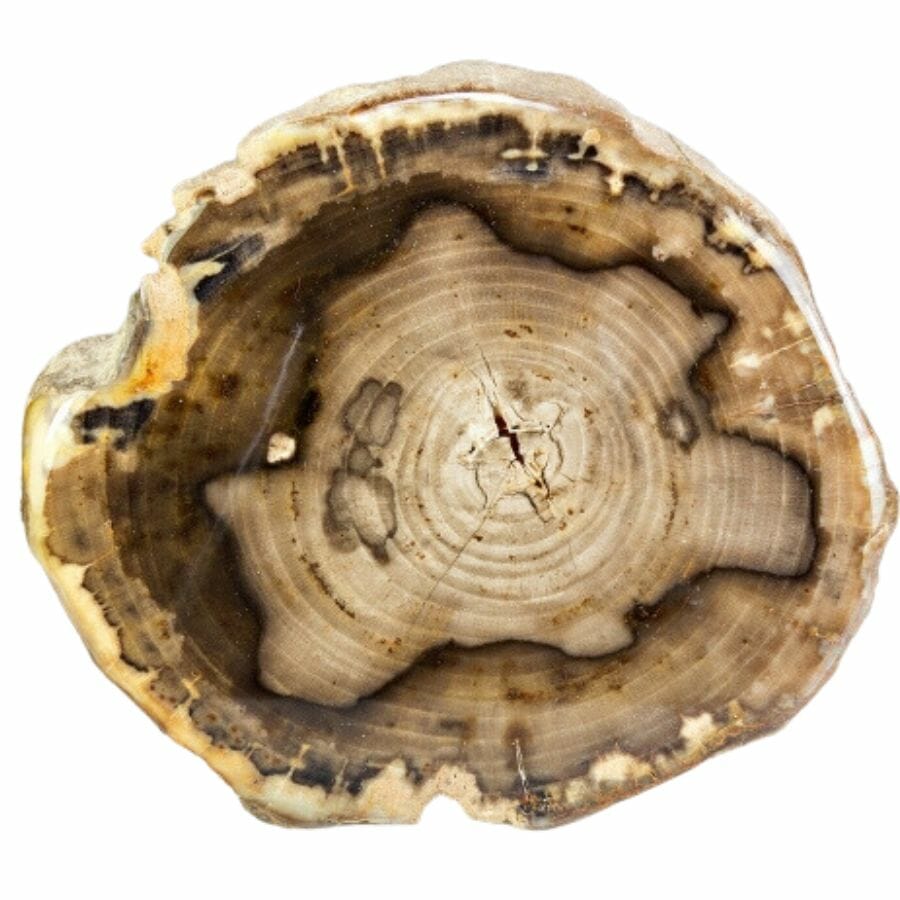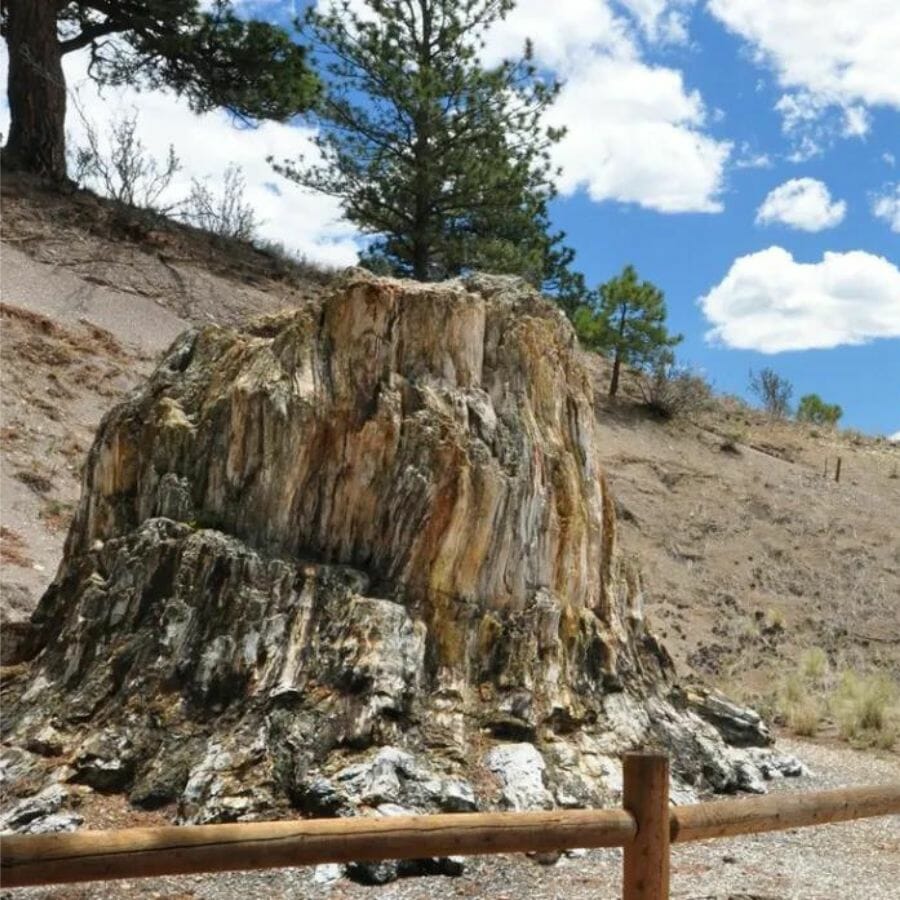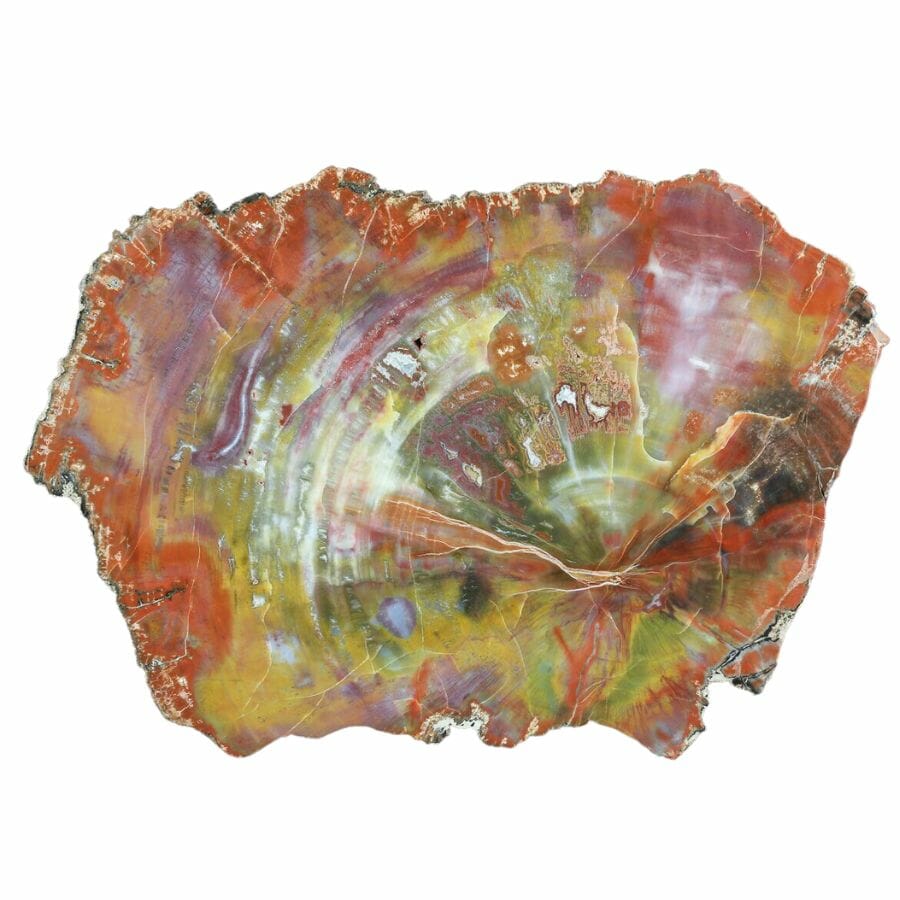Finding petrified wood is like going on an adventure. It’s often found in places that used to have lots of trees and have experienced major changes over time, like areas near volcanoes, in deserts, or places with lots of layers of sedimentary rock.
At first, petrified wood might look like a regular rock. But if you look closely, you can often see patterns that used to be tree rings and the texture of the original wood.
Depending on the types of minerals that turned the wood into stone, petrified wood can be lots of different colors.
We’re going to show you how you can be most successful on your petrified wood hunt. We’ll cover the best places to find petrified wood from our own experience, as well as recommendations from the Rock Chasing community.
We’ll also tell you how you can identify it in the field so you don’t just walk past it without a clue as to what it really is. It can be a bit tricky at first but you’ll learn fast!
What petrified wood is
Petrified wood, a fascinating form of fossil, can provide a glimpse into the past, millions of years ago when the tree was still living.
It’s formed when a tree dies and gets buried under sediment, and groundwater rich in dissolved solids flows through the sediment replacing the original plant material with silica, calcite, pyrite, or another inorganic material such as opal.
This process happens over a very long period, and the result is a rock that looks like wood, hence the name ‘petrified wood’.
How old is petrified wood
The age of petrified wood varies significantly based on where it’s found and the conditions under which it formed. However, most specimens of petrified wood are millions of years old!
For example, some of the petrified wood found in the famous Petrified Forest National Park in Arizona is about 218 million years old. These pieces of petrified wood come from the Late Triassic period, a time when dinosaurs were just beginning to appear on Earth.
Other places may have even older specimens. For instance, in the region of Dholavira, in India, scientists have found petrified wood that’s estimated to be around 247 to 66 million years old!
How long does it take for wood to petrify
The process of petrifaction, which turns organic material like wood into rock, doesn’t happen overnight. In fact, it can take millions of years for wood to fully petrify.
The process begins when a tree or part of a tree falls into an environment with little to no oxygen, like a swamp or a body of water. This slows the decay of the wood and allows it to become buried under layers of sediment.
As time passes, groundwater rich in minerals seeps into the buried wood. The minerals start to fill in the spaces within the cells of the wood. Over a very long time—thousands to millions of years—the wood’s organic material is gradually replaced by these minerals.
This process is so detailed that it can preserve the microscopic structures within the wood, such as growth rings and cell walls.
The types of petrified wood you can find
There are several kinds of petrified wood that you can find in many parts of the world. Naturally, like trees today, most are only found in certain parts of the world.
These are the types of petrified wood you’re most likely to find:
Araucarioxylon

Araucarioxylon is a type of petrified wood that comes from an ancient species of conifer tree, which is related to today’s Araucaria trees, such as the Monkey Puzzle tree. This type of petrified wood is known for its intricate details and beautiful color variations.
You can commonly find Araucarioxylon in the Petrified Forest National Park in Arizona, which is home to large deposits of this petrified wood. This park is a major hub for paleontologists and geologists studying petrified wood, as it provides invaluable insights into the Late Triassic period.
Interestingly, Araucarioxylon is so important to Arizona that it was designated the state fossil. Visiting the Petrified Forest National Park gives you a chance to see these beautiful, naturally-created pieces of art that tell the story of our planet millions of years ago.
Palm

Petrified palm wood is a unique type of fossilized wood that comes from ancient palm trees. This petrified wood has a distinctive spotted look because of the rod-like structures within the grain of the wood.
Petrified palm wood is quite common in the Gulf Coast region of the United States, particularly in Texas and Louisiana. In fact, it’s so common and loved in these states that it has been named the state stone of Texas and the state fossil of Louisiana.
Many of these petrified pieces come from trees that grew when the Gulf Coast was a subtropical jungle, millions of years ago.
Sequoia

Petrified sequoia wood comes from ancient relatives of today’s giant sequoia and redwood trees. These trees, some of the largest and oldest living things on Earth, once covered vast areas and have left a significant record in the fossil record.
One of the notable places where you can find petrified sequoia wood is at the Florissant Fossil Beds National Monument in Colorado. The petrified wood found here is about 34 million years old and gives us a snapshot of a lush, prehistoric forest.
Petrified sequoia wood often shows a high level of detail, revealing growth rings and sometimes even the bark structure.
Cypress

Petrified cypress wood comes from ancient cypress trees that grew in wet, swampy areas, which are great for the process of petrifaction. These areas allow the tree to be quickly covered by water and sediment when it falls.
This type of petrified wood has been found in many parts of the world, from the United States to Australia. In the U.S., a famous location for finding petrified cypress wood is the Petrified Forest of the Black Hills in South Dakota.
This forest is filled with beautiful samples of petrified cypress, some of which are believed to be over 120 million years old.
Oak

Petrified oak wood originates from ancient oak trees, which are known for their strength and long life. When these trees became buried and slowly transformed into stone, they often preserved detailed structures, like the growth rings and unique grain patterns that oaks are known for.
Petrified oak wood can be found in many places across the globe, reflecting the widespread distribution of these trees in both past and present. In the United States, you might find petrified oak wood in states like Arizona, Louisiana, and Mississippi.
Where to find petrified wood near you
With so many different types of ancient trees, there are quite a few different places you can look to find petrified wood. In fact, in most areas, there are going to be some decent spots to find petrified wood near you.
We’ve put together some local guides to help pinpoint the best areas to look:
Petrified Wood Locations In The US
*Click On The State To See The Local Guide*
As you can see on the map above, there are quite a few different places you can look to find petrified wood. Take a look at the various state guides in your region to get an idea of where you should be looking.
You can also click on the links below to see the state guides:
Don’t forget to check back frequently as we add and update our guides regularly.
The Five best spots to find petrified wood in the US
If you’re looking for the very best spots in the US that we know of to find petrified wood you should start with the five below. These are all great options and guarantee that you will see a lot of great examples:
Petrified Forest National Park – Arizona

Petrified Forest National Park, located in northeastern Arizona, is a world-famous destination for those interested in petrified wood. The park spans over 200,000 acres and is filled with vibrant colors from the mineral-rich clay soil and the beautifully preserved petrified logs.
These logs were once part of a lush forest that existed around 225 million years ago.
Visitors can find petrified wood almost everywhere in the park, but one of the best places to see it is along the Giant Logs Trail near the park’s Rainbow Forest Museum. This trail, less than a mile long, is home to some of the largest and most colorful petrified logs in the park.
Remember, while it’s amazing to see and touch the petrified wood, taking any wood or other natural or historical objects from the park is against the law. Instead, take the opportunity to enjoy the scenery, take photographs, and learn about this fascinating window into Earth’s past.
You can also buy legally collected petrified wood from gift shops in the area. That way, you can bring home a piece of the Petrified Forest without damaging this important natural resource.
Mississippi Petrified Forest – Mississippi

The Mississippi Petrified Forest, located near the town of Flora, is one of the few petrified forests in the eastern United States. It’s a site filled with an impressive collection of petrified logs, some of which are several feet in diameter and more than 30 feet long.
The trees were alive about 36 million years ago and were swept away by a prehistoric river system, eventually turning to stone over millions of years.
At the Mississippi Petrified Forest, you can follow a nature trail that meanders through the forest, providing close-up views of these amazing petrified logs. Informational signs along the trail tell the story of the forest’s creation and help visitors understand what they’re seeing.
However, it’s important to note that collecting petrified wood from the forest is prohibited. This helps protect the forest for future visitors and scientific study.
But don’t worry, there’s a gift shop at the forest where you can legally purchase pieces of petrified wood, letting you take home a small piece of ancient history.
Florissant Fossil Beds National Monument – Colorado

Florissant Fossil Beds National Monument in Colorado is known for its stunning array of well-preserved fossils and petrified wood. This area was once covered by a massive ancient lake and a lush forest, home to massive redwood trees.
Around 34 million years ago, a volcanic eruption filled the lake with ash, perfectly preserving the remains of many organisms, including the giant trees.
When you visit, one of the main attractions is the “Big Stump.” This is a huge petrified stump of a redwood tree that once towered over the ancient landscape. You can see this and other petrified stumps along the Petrified Forest Loop, a one-mile trail that takes you through the petrified forest.
Remember, it’s not allowed to remove petrified wood or any other fossils from the park. But that shouldn’t stop you from exploring and enjoying the ancient wonders of this place.
Plus, the visitor center has a collection of fossils and petrified wood you can touch and closely examine, helping you connect with the ancient world that once existed here.
Petrified Forest of the Black Hills – South Dakota

The Petrified Forest of the Black Hills in South Dakota offers a unique opportunity to explore a forest that turned to stone millions of years ago. This private attraction is home to an impressive collection of petrified wood, primarily cypress, that’s believed to be about 120 to 130 million years old.
When you visit, you can take a self-guided tour along a well-maintained trail. This trail takes you through the petrified forest and offers stunning views of the Black Hills.
Along the way, you’ll see petrified logs of all sizes, some standing upright just as they did when they were living trees.
While you’re not allowed to take any petrified wood from the park, there’s a museum on-site where you can see and learn more about petrified wood and other fossils. T
hey also have a gift shop where you can buy petrified wood and other natural souvenirs to take home, letting you keep a piece of this ancient forest with you.
Theodore Roosevelt National Park – North Dakota

Theodore Roosevelt National Park in North Dakota is a fantastic place for nature lovers and fossil enthusiasts alike. While it might be better known for its herds of bison and rugged Badlands scenery, the park is also home to a significant amount of petrified wood.
The park’s North and South Units both have petrified wood scattered throughout their landscapes. Hikers on the Caprock Coulee Trail in the North Unit or the Petrified Forest Loop in the South Unit will often come across chunks of petrified wood.
These pieces are remnants from ancient forests that existed around 55 to 60 million years ago.
However, it’s crucial to remember that removing petrified wood from the park is illegal. Instead, visitors should practice the principles of “Leave No Trace,” which includes leaving natural and cultural artifacts as you found them.
This helps protect the park’s resources and allows future visitors to enjoy them. Enjoy the thrill of discovery, take pictures, and leave the petrified wood for others to discover.
How to identify petrified wood
Now that we’ve given you a lot of different ideas on where you can find petrified wood we want to help you actually spot it in the wild. Being able to identify petrified wood can be a bit tricky but you’ll get the hang of it in no time.
Here are a few different ways you can easily identify petrified wood if you find it:
A texture and appearance that looks like wood

Petrified wood is fascinating because it often maintains the original texture and appearance of the wood it once was, despite now being stone. If you look closely, you’ll likely see the grain of the wood, which shows the pattern the tree’s growth made over the years.
Sometimes, you can even see knots, which are the hard, round areas where a branch was growing. In some rare cases, petrified wood might still show the texture of the bark.
However, when you touch it, petrified wood doesn’t feel like regular wood at all. Instead, it feels cold, hard, and heavy, just like a rock. This is because, over time, minerals have replaced all the organic material of the original tree, turning it to stone.
It can have a wide range of colors

Petrified wood can come in an amazing array of colors, and these are usually due to the different minerals that have replaced the original wood during the petrification process. For instance, iron can cause red, orange, or yellow hues in the petrified wood, making it look like a piece of autumnal art.
Copper, on the other hand, can result in beautiful green or blue tones. Some pieces of petrified wood might also show black or gray colors because of carbon, while manganese can lead to pink or even black colors.
It’s the interaction between the minerals in the ground water and the organic material in the wood that creates these vibrant color variations. So, when you’re looking at a piece of petrified wood, you’re actually seeing a snapshot of the geological conditions from millions of years ago!
Petrified wood is heavier than normal wood

If you’ve ever picked up a piece of petrified wood, one of the first things you might notice is its weight. Unlike regular wood, which is relatively light and porous, petrified wood is significantly heavier. This is because it’s not really wood anymore – it’s a stone.
Over millions of years, the original wood has been completely replaced by minerals, usually silica, from the surrounding soil and water. These minerals are denser than the wood they replace, which is why petrified wood is so much heavier than it looks.
So, if you ever find a piece that looks like wood but is much heavier, there’s a good chance it might be petrified wood. This unique property is one of the most fascinating aspects of petrified wood, and it’s a key way to identify it.
Weight: Petrified wood is heavier than regular wood because it’s essentially rock. If a piece that looks like wood is unexpectedly heavy, it might be petrified wood.
Look for tree ring patterns

One of the more obvious giveaways that you found petrified wood is if you can see the original tree’s growth rings. These are the circular patterns you might see when you look at a cross-section of a tree or log.
Each ring represents a year in the tree’s life, with the width of the ring showing how much the tree grew that year.
Even after millions of years, these patterns can be perfectly preserved in petrified wood. That’s because, as the wood slowly turns to stone, the minerals replacing the wood do so in a way that keeps the original structure, including the growth rings.
So, by examining these rings, not only can you confirm that a piece of rock is petrified wood, but you can also get a glimpse into the life of a tree that lived millions of years ago!
You have to be in the right spot

Finding petrified wood is a bit like a treasure hunt, and a big part of that hunt is knowing where to look. Petrified wood is often found in areas with a rich geological history.
Places that were once ancient riverbeds, volcanic areas, or even swamps are excellent spots to look. These locations had the right conditions millions of years ago to bury wood quickly and deeply, starting the long process of petrification.
Finding petrified wood isn’t just about luck. It’s about understanding where the right conditions existed for wood to be preserved and petrified over millions of years.
It’s shaped like a piece of wood

When we think of the shape of petrified wood, it’s essential to remember that it was once a living tree. Like any piece of wood, it might be found as a branch, a chunk of trunk, or even a complete tree that has fallen over.
The process of petrification often preserves the original shape of the wood, meaning that petrified wood can often still look very much like the tree it once was.
However, over millions of years, erosion can also break the petrified wood into smaller pieces. As a result, you might find petrified wood that’s shaped like a round or oval rock, often with a rough exterior and a smooth, colorful interior.
The shapes can vary widely, but the tell-tale signs of tree rings or bark patterns might give away its true nature as petrified wood.


